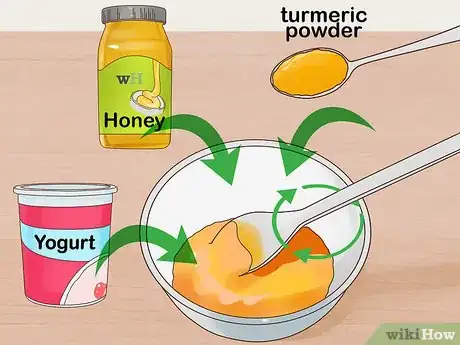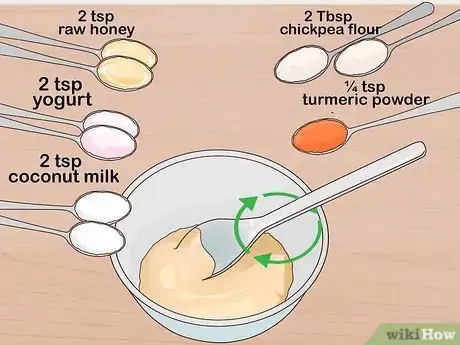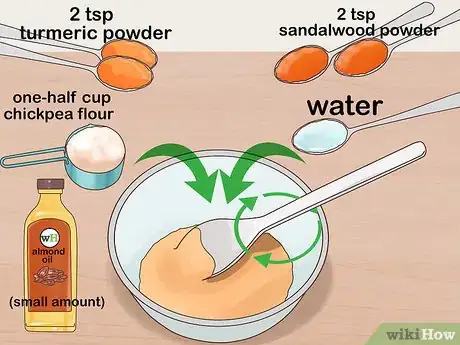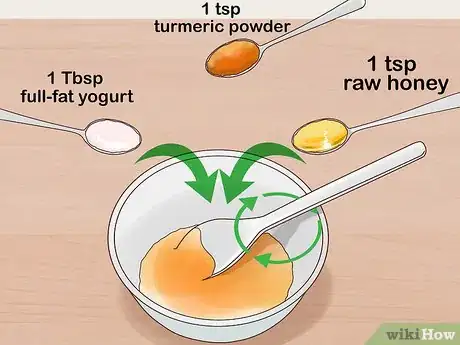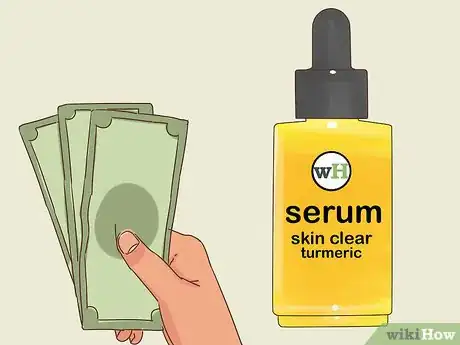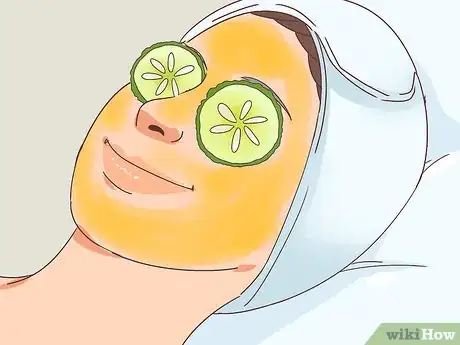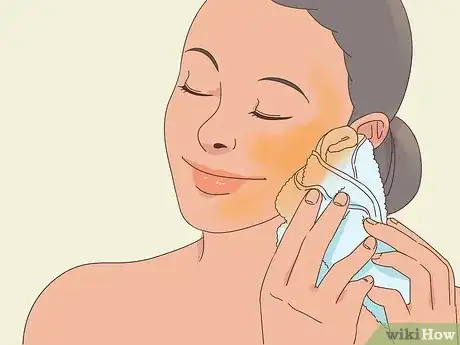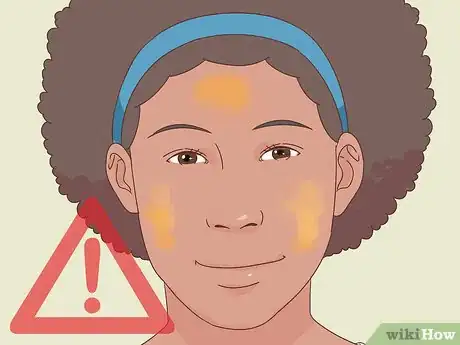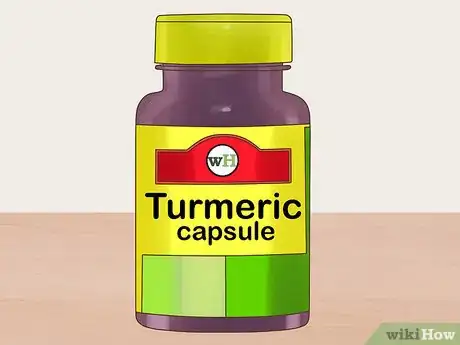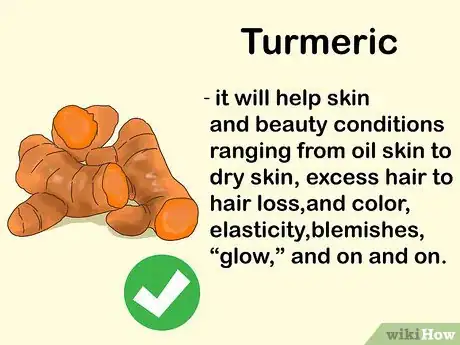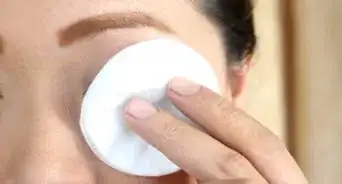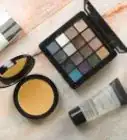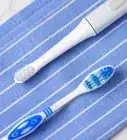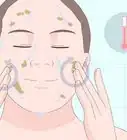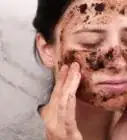This article was co-authored by Diana Yerkes and by wikiHow staff writer, Christopher M. Osborne, PhD. Diana Yerkes is a Skincare Professional and the Lead Esthetician at Rescue Spa in New York City, New York. With over 15 years of experience, Diana helps others with their skin care needs by incorporating natural and high-performing products and treatments into their routines while providing nutrition insights and educating clients on better skin care habits. Diana is a member of the Associated Skin Care Professionals (ASCP) and holds certifications from the Wellness for Cancer and Look Good Feel Better programs. She received her esthetics education from the Aveda Institute, the International Dermal Institute, and the Biologique Research Academy.
This article has been viewed 56,569 times.
If you’ve ever had an Indian curry dish, you know the warmth, spice, and color that turmeric can add to food. Derived from a shrub and related to ginger, turmeric is usually sold in its distinctly-yellow powdered form. For centuries, millions of people have sworn by turmeric as a cure for a wide range of internal and external health concerns. And, while the modern scientific evidence is limited at best, there is little risk to giving turmeric a try. So, consider swapping out your curry for a turmeric face mask as part of a skincare regimen.
Steps
Making Turmeric Pastes for Skincare
-
1Whip up a basic face mask paste. Since turmeric has been used as a skincare product for so long by so many people, it should be no surprise that there are countless recipes out there. The following is a simple, basic, general use facial paste that may be a good choice if you’re new to turmeric skincare:[1]
- Add a few tablespoons of turmeric powder to a bowl (start with a smaller amount and mix up more if you need it).
- Add a bit of honey and enough full-fat yogurt or milk to create a smooth paste when stirred. Make it thin enough to apply to your skin easily but thick enough that it will stay in place.
- Use it as a 20-minute face mask or for topical application on problem areas, which can range from chapping to acne to age spots.
-
2Go for a “glowing skin” face mask. If you’re trying to retain or restore your face’s youthful luster, try one of the many turmeric pastes that claim to give your skin some extra glow. The following is a simple example:
- In a bowl, mix 2 Tbsp chickpea flour (besan flour), ¼ tsp turmeric powder, 2 tsp raw honey, and enough yogurt, coconut milk, or water to form a smooth but dense paste.
- Apply it to your clean face with your clean fingers. Let it dry for 10-15 minutes.
- Wipe and rinse your face clean and pat dry. Apply moisturizer if desired.
Advertisement -
3Try a traditional Indian beauty mask. Turmeric has long been a staple of both cuisine and skincare in India. To this day, many Indian brides swear by a turmeric beauty mask in the days leading up to the marriage ceremony. The following recipe draws from common beauty mask recipes:[2]
- Mix 2 tsp of sandalwood powder, 2 tsp of turmeric powder, and one-half cup of chickpea flour (besan flour) in a bowl.
- Stir in a small amount of almond oil and/or ghee (clarified butter) and enough water to make a smooth, rich paste.
- Apply this facemask, leave it on until it dries, and then wipe and rinse it away completely.
-
4Address skin inflammation with turmeric paste. Turmeric skincare advocates have long championed its supposed anti-inflammatory properties, and modern science has started to uncover shreds of evidence that this may possibly be true.[3] Try the following simple recipe as a face mask or for topical applications:[4]
- Mix 1 Tbsp of full-fat yogurt, 1 tsp of turmeric powder, and 1 tsp of raw honey in a bowl. Mix it until a smooth paste forms.
- Apply it as a facial or use it topically on inflamed areas of the skin.
-
5Try the endless array of turmeric skin recipes. Use your favorite browser to search for “turmeric face masks” or “turmeric skin care” in order to reveal a seemingly limitless number of recipes. Some of them combine turmeric with oatmeal, another food product renowned for its skincare benefits, or other common facemask ingredients like lemon juice, aloe, and rose water.[5]
- You are very unlikely to see any negative effects from trying a turmeric skincare recipe. However, if you do develop any type of irritation, rash, discomfort, etc., remove the product immediately and discontinue its use. In this case, or in an abundance of caution otherwise, talk to your doctor or dermatologist first.[6]
-
6Buy turmeric skincare products. If you have some turmeric powder, honey, and milk or yogurt in your home, you can easily make your own simple turmeric face mask. However, if you don’t want to mix up your own concoction, don’t have easy access to turmeric powder, or simply prefer commercial skincare products, you’ll have your choice from a wide range of products that contain turmeric.[7]
- You can buy turmeric-infused serums, masks, cleansers, and so on; but be prepared to spend at least $25 for a bottle.
Applying and Removing Turmeric Facials
-
1Prepare your skin. To maximize the absorption and impact of a turmeric-based facial paste, you should first thoroughly (but gently) clean your skin and open your pores. And honestly, what better way is there to begin a relaxing facial than with a nice, warm bath?[8]
- Take a warm bath or shower to open up your pores. While doing so, cleanse your face and body with a gentle soap that removes dirt and impurities without overly drying or irritating your skin. Rinse away the soap completely with clean, warm water, and dry your skin thoroughly but gently with a soft, clean towel.
-
2Relax and enjoy the process. Turmeric facials aren’t meant to be a quick, on-the-go treatment. Wait until you have some time to sit back, relax, and enjoy the process without rushing it. Once you’ve applied your turmeric concoction of choice, recline in a comfy bed, chair, or other nice spot where you can wait 20 minutes or more for the paste to dry.[9]
- Place cucumber slices or steeped and cooled chamomile tea bags on you eyes to enhance the relaxation quotient.
- Use towels to protect your chosen reclining spot, and any clothes you are wearing. Turmeric facial pastes will stain fabrics.
-
3Remove the paste and rinse and dry your face thoroughly. Although most turmeric facials should be allowed to dry thoroughly on your skin, they can usually be removed fairly easily with a clean cloth, warm water, and gentle but thorough wiping, dabbing, and rubbing. Once again, don’t rush things. Meticulously and calmly wipe away the paste.[10]
- You can use moistened cotton balls or swabs to remove the dried paste from creases and crevices. Once the paste is completely removed, rinse your face with warm water, splash it with cool water, and pat it dry with a clean towel.
-
4Watch for turmeric staining. The vibrant golden color of turmeric powder lends credence to warnings that pastes that include it can cause yellowish discolorations of your skin. These concerns tend to be overblown, however. If a turmeric facial does cause a yellowing of your skin, it should only be temporary and should wear or wash away without much trouble.[11]
- If you are getting married or have a big interview the next day, have fair skin, or are simply concerned about possible discoloration, test your paste on a less conspicuous area of your flesh first (akin to testing cleaners on fabrics). If there is staining, see how much time and effort it takes to remove it. You might also want to consider reducing the amount of turmeric in your recipe, if necessary.
- Turmeric pastes can, however, cause hard-to-remove stains on clothing, furniture fabrics, carpets, and so on. When mixing, applying, and removing a turmeric facial, use plenty of towels (that are okay to get stained) to protect clothing and fabrics.
Using Turmeric Regularly and Safely
-
1Consume turmeric-infused foods and beverages. Can eating or drinking turmeric improve your skin? As with topical applications, there is scant hard evidence that would support such claims. But, turmeric is unlikely to do any harm and can add quite an appealing zing to a wide range of recipes.
- From the countless curry recipes that include turmeric, to turmeric teas and “golden milk,” to turmeric powder sprinkled into soups or scrambled eggs, you really have limitless options for increasing your daily intake through food and drink.
- See Include Turmeric in Your Diet for some great ideas, tips, and recipes.
-
2Look into turmeric supplements. Turmeric can also be taken directly as a dietary supplement, in powdered, capsule, or other forms. People take turmeric supplements in hope that it will help prevent conditions ranging from Alzheimer’s to cancer and beyond, although, again, such evidence is sketchy at best. But, so long as you stick within recommended dosage ranges (for instance, in powdered form, 400-600 mg three times daily), it is unlikely to cause negative effects.
- However, if you have high blood pressure, take stomach acid reducing medicines, have gallstones, have diabetes, are pregnant or nursing, take blood thinners, or are going to undergo surgery, consult a doctor first. In reality, it is best practice to consult with your physician regarding all supplements you take.
- Check out Take Turmeric Powder for more insights on turmeric supplements and restrictions.
-
3Accept the limited science behind turmeric benefits. Beyond the wide-ranging medical benefits claimed for turmeric, advocates for this golden powder say it will help skin and beauty conditions ranging from oil skin to dry skin, excess hair to hair loss, and color, elasticity, blemishes, “glow,” and on and on. Can it do all or any of these things? Maybe. Will it work for you? Maybe.
- You simply have to accept that there are a lot of “mays” involved when talking about using turmeric for skincare. For instance, it may have anti-oxidant and anti-inflammatory properties. There simply have not been many detailed scientific studies done to support or reject turmeric health claims. The bottom line seems to be this: turmeric is unlikely to hurt you; and it may help you, but is at least as likely to do nothing.[12]
Expert Q&A
-
QuestionCan Turmeric get rid of dark spots?
 Diana YerkesDiana Yerkes is a Skincare Professional and the Lead Esthetician at Rescue Spa in New York City, New York. With over 15 years of experience, Diana helps others with their skin care needs by incorporating natural and high-performing products and treatments into their routines while providing nutrition insights and educating clients on better skin care habits. Diana is a member of the Associated Skin Care Professionals (ASCP) and holds certifications from the Wellness for Cancer and Look Good Feel Better programs. She received her esthetics education from the Aveda Institute, the International Dermal Institute, and the Biologique Research Academy.
Diana YerkesDiana Yerkes is a Skincare Professional and the Lead Esthetician at Rescue Spa in New York City, New York. With over 15 years of experience, Diana helps others with their skin care needs by incorporating natural and high-performing products and treatments into their routines while providing nutrition insights and educating clients on better skin care habits. Diana is a member of the Associated Skin Care Professionals (ASCP) and holds certifications from the Wellness for Cancer and Look Good Feel Better programs. She received her esthetics education from the Aveda Institute, the International Dermal Institute, and the Biologique Research Academy.
Skincare Professional Turmeric contains curcumin, which may help reduce inflammation, redness, and acne.
Turmeric contains curcumin, which may help reduce inflammation, redness, and acne.
References
- ↑ http://www.turmericforhealth.com/turmeric-cures/turmeric-masks-for-great-skin
- ↑ http://www.turmericforhealth.com/turmeric-cures/turmeric-masks-for-great-skin
- ↑ https://nccih.nih.gov/health/turmeric/ataglance.htm
- ↑ http://abcnews.go.com/Lifestyle/turmeric-big-trend-skincare-products/story?id=31661057
- ↑ http://www.turmericforhealth.com/turmeric-cures/turmeric-masks-for-great-skin
- ↑ https://nccih.nih.gov/health/turmeric/ataglance.htm
- ↑ http://abcnews.go.com/Lifestyle/turmeric-big-trend-skincare-products/story?id=31661057
- ↑ http://www.turmericforhealth.com/turmeric-cures/turmeric-masks-for-great-skin
- ↑ http://www.turmericforhealth.com/turmeric-cures/turmeric-masks-for-great-skin
